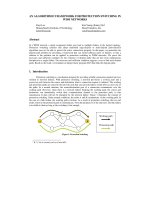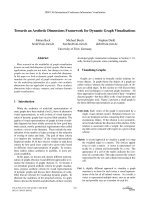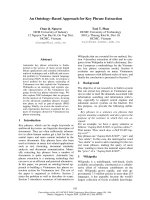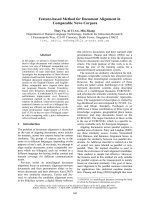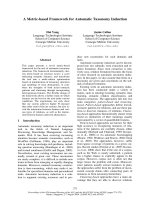Crafting an interests based framework for mediation advocacy in singapore
Bạn đang xem bản rút gọn của tài liệu. Xem và tải ngay bản đầy đủ của tài liệu tại đây (1.29 MB, 164 trang )
Crafting An Interests-based Framework for Mediation Advocacy in Singapore
CRAFTING AN
INTERESTS-BASED FRAMEWORK
FOR MEDIATION ADVOCACY
IN SINGAPORE
GOH CHOONG SIEN, ALOYSIUS
(L.L.B. (Hons), NUS)
A THESIS SUBMITTED FOR THE DEGREE OF MASTER OF LAWS
DEPARTMENT OF LAW
NATIONAL UNIVERSITY OF SINGAPORE
2008
Aloysius Goh
NUS Matric No.: HT 070880X
Page 1
Crafting An Interests-based Framework for Mediation Advocacy in Singapore
Acknowledgements
I wish to express my gratitude to –
Professor Joel Lee for his patient mediation of my diverse interests and
perspectives, for helping me negotiate through difficult times with “very funny” jokes,
and for his wisdom and intellect inspiring me to give my best at all times;
Professor Andrew Simester for the research and writing tips that made the effort
invested in this paper a more useful contribution to mediation practice in Singapore;
Professor Alan Tan for assisting me through his generous and understanding
support as Vice-dean;
The National University of Singapore for providing me with the Research Scholarship
to make this fulfilling intellectual endeavour possible;
And, last but, by far, not least,
My parents.
Aloysius Goh
NUS Matric No.: HT 070880X
Page 2
Crafting An Interests-based Framework for Mediation Advocacy in Singapore
CRAFTING AN INTERESTS-BASED
FRAMEWORK FOR MEDIATION
ADVOCACY IN SINGAPORE
TABLE OF CONTENTS
Chapter
Description
Page
PART 1
EXECUTIVE SUMMARY
9
Why a Mediation Advocacy Paper
1
DEFINING MEDIATION
12
What is A Successful Mediation?
1.1
1.2
Principles of Facilitative Mediation
Practical Solutions Focused on Parties‟ Interests
14
Voluntary Involvement to Negotiate in Good Faith
17
Mediator Neutrality
18
Confidential and Without Prejudice
19
Empowerment of Parties
20
The Mediation Process
Stage 1: Introduction By Mediator
23
Stage 2: Opening Statements By Parties and Mediator
Summary
24
Stage 3: Joint Sessions: Identifying Issues, Interests, and
Options
26
Stage 4: Private Caucus: Separate meetings and Breaks
28
Stage 5: Subsequent Joint Session
30
Stage 6: Agreement
31
Aloysius Goh
NUS Matric No.: HT 070880X
Page 3
Crafting An Interests-based Framework for Mediation Advocacy in Singapore
2
2.2
2.2
ADVANTAGES OF MEDIATION FOR THE PARTY AND
HIS ADVOCATE
33
Advantages for the Client
High chances of success
33
Unique Interest-based Settlement
34
Low and Predictable Cost
35
Advantages for Advocates
Bring Client to Reality
Keeping the Client
Strengthening Social Harmony
37
38
40
PART 2
3
MEDIATION PRACTICE IN SINGAPORE
42
Low Pick-up Rate by Practitioners and Public
3.1
Factors for the Slow Pick-up of Mediation to Resolve Disputes
Adversarial Training from Law Schools
44
Insufficient Checks on Mediator Conduct
48
Absence of Uniform Guidelines to Determine Ethical
Mediation Practice
A Top-down Pressure for the Use of Mediation
50
53
Scarcity of Specialists Assisting Parties in Mediation
Preparation
57
Lack of Motivation for Practitioners to Invest in Bringing
Positive Change
Aloysius Goh
NUS Matric No.: HT 070880X
59
Page 4
Crafting An Interests-based Framework for Mediation Advocacy in Singapore
PART 3
4
THE MEDIATION ADVOCATE
63
Problem Solver
65
Astute Collaborator
67
Ethical Practitioner
69
5
ASSESSING THE SUITABILITY OF THE CASE FOR
MEDIATION
75
5.1
Characteristics Of A Dispute Ideal For Mediation
77
78
There are ongoing relationships at stake
The
resolution
has
significant
consequences
for
important third parties
79
The outcome preferred is very specific and goes beyond
financial aspects or seeking vindication
Communication breakdown has a role in the dispute
80
82
The value of the claim does not justify the cost or time
required for litigation
83
The resolution desired is time-sensitive
85
There are few issues of law in question
86
There is an existing contract or legislation mandating the
use of mediation
5.2
88
The time is ripe for mediation
91
Confidentiality is important to at least one of the parties
92
When Mediation May be Inappropriate
Criminal charges will be pressed against a party in the
mediation.
93
Where There Is An Important Public Policy Interest.
95
A party is irrational and dedicated to acting in bad faith
96
Aloysius Goh
NUS Matric No.: HT 070880X
Page 5
Crafting An Interests-based Framework for Mediation Advocacy in Singapore
5.3
Conclusion
6
PREPARING A CASE FOR MEDIATION
6.1
Reviewing The Relevant Documents
Identifying Needs and Interest
Ascertain the Relevant Law
Recognize the available evidence
6.2
97
99
100
102
103
Understand The Relationship Between The Client And The
Other Parties
106
6.3
Estimate The Other Parties’ Interests
106
6.4
Generate and Prioritize Options
107
6.5
Identify and Clarify the Client’s Key Doubts
108
6.6
Plan To Restore Client’s Confidence In Collaboration
109
6.7
Consider the Context and Timing
111
7
PREPARING THE CLIENT FOR MEDIATION
7.1
Increasing the Client’s Understanding of Mediation
7.2
Steps to Prepare the Client
114
Explaining the Roles
Role of the Mediator: Facilitate
120
Role of Parties: Engage
121
Role of the Advocate: Support
122
Explain the Focus: Interests not Rights
124
Explain the Nature of the Process and Outcome:
Voluntary, Confidential, and Without Prejudice
Explain the Process Flow and Structure
Aloysius Goh
NUS Matric No.: HT 070880X
126
127
Page 6
Crafting An Interests-based Framework for Mediation Advocacy in Singapore
7.3
Deciding who should attend
128
Use of Experts
130
Developing a Mediation Strategy
Crafting an Overall Theme to set Realistic Goals
132
Preparing for the Possible Obstacles to a Mediated
Settlement
133
Helping clients decide on the type and timing of
collaborative signals
7.4
8
Conclusion
REPRESENTING THE CLIENT AT THE MEDIATION
8.1
Opening Statement by the Parties
8.2
First Joint session
135
137
139
141
(a) Agenda-setting
144
(b) Option Generation
145
8.3
Private Caucuses
147
8.4
Advising the client
148
8.5
Subsequent Joint Sessions and Settlement
150
CONCLUSION
Aloysius Goh
NUS Matric No.: HT 070880X
153
Page 7
Crafting An Interests-based Framework for Mediation Advocacy in Singapore
APPENDIX
Annex A:
Diagram 1 – Mediation Process Flowchart
160
Annex B:
Checklist For Determining The Suitability Of A Case For Mediation
161
Annex C:
Preliminary Stages Of Preparation For Mediation
162
Annex D:
The Marks Of A Satisfying Mediation
164
Aloysius Goh
NUS Matric No.: HT 070880X
Page 8
Crafting An Interests-based Framework for Mediation Advocacy in Singapore
EXECUTIVE SUMMARY
WHY A MEDIATION ADVOCACY PAPER
Mediation stands as both a catalyst and fruit of the evolving world order. Drawing
from the advances in technology, psychology, and dispute resolution, mediation at once
represents and reinforces the sanctity of the individual and the community, unites the pursuit
for efficiency and for peace, and merges the quest for order and for freedom. Progress in the
understanding of mediation‟s advantages has seen it extend to medical, construction, finance,
trade, family, international diplomacy, and community disputes. Policy-makers in both civil
and common law jurisdictions including France, China, the USA, the United Kingdom,
Australia, New Zealand, Singapore, and Malaysia have institutionalized mediation as a
dispute resolution process, recognizing that mediation possesses “all the virtues absent in
litigation and arbitration”. 1 Many more jurisdictions are now actively promoting the
formalization and use of mediation, positioning it as a strong option for those at the forefront
of dispute resolution practice. Most recently, on 21 May 2008, the European Commission
unanimously adopted a European Mediation Directive (EMD). Art 1(1) of Directive
2008/52/EC describes its objective as “to facilitate access to alternative dispute resolution and
to promote the amicable settlement of disputes by encouraging the use of mediation and by
1
Then-Attorney General Chan Sek Keong, Speech at the Opening of Legal Year, on 6 January 1996.
(Hereinafter “Chan Sek Keong, Opening of Legal Year Speech, 1996”.)
Aloysius Goh
NUS Matric No.: HT 070880X
Page 9
Crafting An Interests-based Framework for Mediation Advocacy in Singapore
ensuring a balanced relationship between mediation and judicial proceedings”. In the United
States, the growth in mediation practice has been further enhanced with private firms using
the internet to offer dispute resolution services including mediation across geographical
boundaries creating a multi-million dollar industry.2
Notwithstanding the optimism that these trends bring to advocates of mediation, there
are also grave reasons for concern. Mediation continues to be less popular compared to
adversarial forms of dispute resolution like litigation and arbitration. Malpractice by
mediators remains difficult to ascertain and correct. There is a lack of clear guidelines to
determine ethical mediation practice. Practitioners lack motivation to invest effort in bringing
about positive change. All of which lead to a scarcity of experts in the goals, process, and
methods of mediation who specialize in assisting parties in preparation and presentation.
Drawing from the work of leading dispute resolution commentators, the first part of
this paper will begin by defining the core elements of mediation and mediation advocacy. It
maps out the salient features of the ideal mediation process and describes how mediation‟s
goals, processes, and methods give it its unique advantages over litigation and arbitration.
The root causes of mediation‟s unpopularity are considered in the second part through the
firsthand experience of the writer at legal firms and training in law schools, interviews with
mediators in Singapore, as well as research material from other legal jurisdictions, the
implications of the findings are examined on a micro- and macro-level. It will conclude that
the presence of expert mediation advocates who adhere to a common body of best practices
2
The two biggest are www.squaretrade.com and www.cybersettle.com. Both are online dispute resolution
platforms where parties may choose to negotiate directly or appoint a third party mediator or arbitrator. Their
websites claim they have successfully mediated more than a million disputes. Notably, even the European
Commission has initiated involvement in this industry through its financial involvement in the launching of
ECODIR (Electronic Consumer Dispute Resolution Platform), an electronic dispute resolution platform.
Aloysius Goh
NUS Matric No.: HT 070880X
Page 10
Crafting An Interests-based Framework for Mediation Advocacy in Singapore
lies at the heart of the possible solutions to the problems. Finally, using a comparative
analysis of the existing published codes of conduct for mediators locally and internationally,
and matching them with the suggestions of experienced practitioners, the third part aims more
ambitiously at en-fleshing some of the fundamental duties and best practices of the
specialized mediation advocate. By defining the nature of the mediation advocate‟s work, the
writer aims to: Increase the public‟s understanding of the goals and methods of mediation;
Provide a platform for clearer standards of care to be created in mediation
practice;
Enhance protection for parties in mediation;
Increase public confidence in the efficacy of the mediation process;
Increase mediation‟s popularity;
Meaningfully engage key stakeholders (mediators, advocates, and parties) in
monitoring and improving the standard of mediation practice;
See a more effective translation of mediation‟s personal and social goals into
the society‟s dispute resolution environment.
Aloysius Goh
NUS Matric No.: HT 070880X
Page 11
Crafting An Interests-based Framework for Mediation Advocacy in Singapore
PART 1
CHAPTER 1
DEFINING MEDIATION
“Mediation is a voluntary and confidential process in which the parties seek to find a
practical solution to their dispute. The parties are guided in their decision-making process by
a neutral third party, the mediator, who assists the parties in finding a solution to which both
assent and which has regard to the different concerns of those involved.”3
What is A Successful Mediation?
The mediation industry is more pluralistic than monolithic. There are at least four
distinct mediation models that are popularly used:4
The Settlement Model is common in disputes between two parties and involving small
sums of money (e.g. in online mediations). The priority is to arrive at a quick solution
with each party compromising on their initial claims. Mediators are like arbitrators
3
Loong Seng Onn, Executive Director, Singapore Mediation Centre, Mediation in Singapore, updated on 12
June 2006, available at last visited on 10 June 2008.
(Hereinafter “Loong Seng Onn, Mediation in Singapore”)
4
L. Boulle, Mediation: Principles, Process, Practice (Sydney, Lexis Nexis, 2005), at 43-47. For a discussion on
the different styles of mediators, see Leonard L. Riskin, Understanding Mediators‟ Orientations: Strategies and
Techniques: A Grid for the Perplexed, 1 Harv. Negot. L. Rev (1996) 7; and Leonard L. Riskin, Retiring and
Replacing the Grid of Mediator Orientations, 21 Alternatives 69 cited in Dwight Golann and Jay Folberg,
Mediation: The Roles of Advocate and Neutral (USA, Aspen Publishers, 2006) at 116-119 (Hereinafter “Golann
and Folberg, The Roles of Advocate and Neutral”.)
Aloysius Goh
NUS Matric No.: HT 070880X
Page 12
Crafting An Interests-based Framework for Mediation Advocacy in Singapore
who indicate what they assess to be a reasonable middle ground, and parties agree to
be bound by this.
Court Dispute Resolution (CDR) Services in Singapore practice what is most akin to
an Evaluative Model of mediation. Evaluative Mediators tend to be specialists or
people of high standing in society including former or senior judges. Their role is to
listen to each party‟s opinion of the conflict, offer their opinion of the award each
party may receive in court, and suggest what they assess to be a reasonable solution to
the mutual benefit of the parties. It is again similar to arbitration with the emphasis on
efficiency and less on empowerment of the parties to come to a solution.
In the Therapeutic model, the priority lies in providing therapy and counsel. The
assumption of the mediator, who is usually a qualified therapist or counselor, is that
the problem lies in the clash of the parties‟ personalities. The goal is not to solve the
problem but to guide the parties to experience personal growth through the conflict.
Finally, there is the Facilitative Model which is the model that is advocated in this
thesis and will be elaborated in greater detail in the following section.
Intended to be adaptable to the diverse nature of parties and dispute, the mediation process is
flexible and there is no single model of mediation that is right or wrong. 5 With participants in
mediation potentially having different goals, there are many possible definitions of a
successful mediation. Furthermore, social, cultural, and political, factors as well as the
5
See for example, RAB Bush and JP Folger, The Promise of Mediation: Responding to Conflict through
Empowerment and Recognition (San Francisco, Jossey-Bass, 1994) at 2 (Hereinafter “Bush and Folger, The
Promise of Mediation”.)
Aloysius Goh
NUS Matric No.: HT 070880X
Page 13
Crafting An Interests-based Framework for Mediation Advocacy in Singapore
background of mediators, all have an impact on the type of mediation practised. 6 For the
purposes of this paper, focus is placed on the facilitative mediation which is the only model
that defines a successful settlement as requiring the achievement of the following goals:-
Settlement of the dispute that brought the parties to mediation;
Resolution of the underlying conflict that led to the dispute; and
Empowerment of the parties to manage the present and future conflicts.7
How facilitative mediation achieves successful settlements is in its unique approach
towards dispute resolution through its emphasis on its five core principles which are
explained below.
Principles of Facilitative Mediation
Practical Solutions derived through an interest-based approach that focuses on parties‟
interests and collaboration.
Facilitative mediators adopt an interest-based approach to the dispute resolution. The
focus is not on who has the more justifiable legal position. The mediator is not there to
adjudicate on the rights of the parties. The intention is to defuse the competitive bargaining
tendencies. Parties are invited to look beyond their initial positions to consider their
6
L C Nielson, Mediators‟ and Lawyers‟ Perceptions of Education and Training in Family Mediation, Mediation
Quarterly 12 (1994) 2.
7
Stephen B. Goldberg, Margaret L. Shaw, The Secrets of Successful (and Unsuccessful) Mediators Continued:
Studies Two and Three, Negotiation Journal 23 (2007) 393–418 (Hereinafter “Goldberg and Shaw: The Secrets
of Successful Mediators”.)
Aloysius Goh
NUS Matric No.: HT 070880X
Page 14
Crafting An Interests-based Framework for Mediation Advocacy in Singapore
underlying interests and motivations. 8 Occasionally acting as a conduit, the mediator
carefully orientates the flow of information towards what can be done in future rather than
what was done in the past.9 Unlike the adversarial models of litigation and arbitration, the
settlement is based on meeting each of the parties‟ needs and creating value.10 Parties are led
to give up irrational anchors to their initial positions to allow exploration of ways to satisfy
deeper interests. 11 In this way, the interest-based approach adopts a problem-solving model
which is focused on solving the problems between the parties for the long-term. MenkelMendow, describes the problem-solving model well in the following,
“One of the key differences between the conventional adversarial model and the
problem-solving model is the extent to which the parties and their lawyers engage in a
continually interactive negotiation process, using the opportunity to seek new
solutions rather than simply moving along a predetermined linear scale of
compromise.”12
The distinct mark of a successful facilitative mediation is the creation of a solution
that satisfies the interests of all the parties in a more comprehensive and hence lasting way
than would have been possible in adjudicated resolutions.13 The mediator facilitates by active
listening.14 This requires him to give appropriate feedback to the parties as they convey to
8
Jean Sternlight, Lawyers' Representation Of Clients In Mediation: Using Economics And Psychology To
Structure Advocacy In A Nonadversarial Setting, 14. [1999] Ohio St. J. on Disp Resol. 269-366 at 337
(Hereinafter “Sternlight, Using Economics and Psychology to Structure Advocacy”.)
9
Carrie Menkel-Meadow, Ethics in Alternative Dispute Resolution: New Issues, No Answers from the
Adversary Conception of Lawyers' Responsibilities, 38 S. Tex. L. Rev. 407, 429 (1997).
10
Kimberlee K. Kovach, Good Faith in Mediation-Requested, Recommended, or Required? A New Ethic, 38
(1997) S. Tex. L. Rev. (Hereinafter, “Kovach, Good Faith in Mediation”.)
11
Sternlight, Using Economics and Psychology to Structure Advocacy, supra note 8 at 337.
12
Carrie Menkel-Meadow, Toward Another View of Legal Negotiations: The Structure of Problem Solving 31
(1981) UCLA L. Rev. 754-841 at 839.
13
George Lim, The Role of Lawyers in Mediation – A Singapore Perspective, Law Gazette, Sept 2000 (2) 1, at 2
(Hereinafter “Lim, Role of Lawyers in Mediation”.)
14
See generally Christopher W. Moore, The Mediation Process (3d ed. Jossey-Bass, San Francisco, 2003) at 3.
Aloysius Goh
NUS Matric No.: HT 070880X
Page 15
Crafting An Interests-based Framework for Mediation Advocacy in Singapore
him their perspectives of the problem to demonstrate to the parties that the message has been
understood. By reflecting, validating, reframing, showing empathy, summarizing, and asking
timely questions, the mediator seeks firstly to identify the underlying interests of the parties
and secondly to expand the resources available to meet those interests. “Interests” are
constituted by the needs, desires, and fears behind each party's position.15 This then is the
vital difference from litigation and arbitration where focus is predominantly on the parties‟
claims or rights.
Parties come to understand that the purpose of their presence is to craft a solution that
looks to the long-term and reduces the chances of further conflict. For example, in a case
where one neighbour has sued the other for damages for hitting him during an argument, the
claim may be monetary in nature. However, the real interests or concerns of the parties are to
find a solution that would allow them to live in harmony. Winning a court-ordered claim
would likely intensify the conflict, providing fuel for future aggression resulting in a victory
that is likely to be short-term and hollow. On the other hand, finding a solution in the
problem-solving approach would seek to create a deeper mutual understanding necessary for
restoring peace of mind for both parties. The solution is more concerned with the practical
realities that they have to continue living together than with who was really right or wrong.
In the interest-based approach, the potential value of a case would be limited only by
how well the parties understand each others‟ needs and resources. By ensuring that the
interests of both parties are met, the mediator does not aggravate the conflict by his
intervention, and the settlement would likely be more happily and effectively enforced than a
litigated one.
15
Roger Fisher, William Ury and Bruce Patton, Getting to Yes, Second Ed. (USA, Random House, 1999) at 4043. (Hereinafter “Fisher et al., Getting to Yes”.)
Aloysius Goh
NUS Matric No.: HT 070880X
Page 16
Crafting An Interests-based Framework for Mediation Advocacy in Singapore
Voluntary involvement founded on an adequate understanding of the responsibilities of
negotiating in good faith
For the practical solution to work, the parties‟ willingness to settle the conflict is
fundamental. Given that the parties are the primary stakeholders in the discussions, the
decision to mediate should come voluntarily from them.16 Parties‟ consent should be founded
on a rational assessment of how mediation better enables to achieve their goals compared to
the other dispute resolution processes available. In choosing mediation, the parties recognize
that their interests are neither served by the status quo nor would they be enhanced by an
adversarial stance.
It is debatable whether parties who are ordered by the court to go for mediation do so
voluntarily. While at first glance, parties have to consent to attending the mediation and retain
the right to leave at any point without prejudice to later judicial proceedings, when viewed in
the context of its execution, it is much harder to confidently affirm that the parties‟
involvement is voluntary.
Amendments to the CMC Act in 2004 now authorize a Magistrate to refer the
complaint to a mediator of a Community Mediation Centre for mediation with or without the
consent of both the complainant and the person complained against..17 That the failure to
attend the mediation as referred by the Magistrate brings with it a contempt of court charge
16
For mediation at Community Mediation Centres, this is mandated by section 12, Community Mediation
Centre(CMC) Act, (Cap. 49A). However, this is qualified by section 15(1)(b) of the same act where magistrates
may order mediation without the parties‟ consent.
17
Sections 12 and 15 CMC Act. See also, rule 25(1) Subordinate Court Practice Directions.
Aloysius Goh
NUS Matric No.: HT 070880X
Page 17
Crafting An Interests-based Framework for Mediation Advocacy in Singapore
creates strong pressure on parties to mediate given their fear of committing an offence.18 And
lastly, strong financial incentives are offered, as mediators are employed by the court system
not by the parties, and parties stand to make significant savings of legal costs and time.19
Mediator Neutrality testified by process impartiality and non-judgmental approach to the
substantive facts
In addition to his ability to resolve the dispute amicably and effectively, arguably the
most salient measure of the mediator‟s competence is his ability to maintain the parties‟ trust
in his neutrality.20 The mediator's influence is largely dependent on the willingness of the
parties and advocates to accept his guidance. In assisting the parties to reach an agreement
amongst themselves, the mediator has a stake in finding a settlement but not in the specific
mediated settlement. 21 His intervention is not by adjudicating but by being an effective
listener and questioner, seeking to influence all parties to view the reality of the consequence
of continuing the dispute and take steps helpful to reaching an agreement.
For purists, a “neutral” mediator should have no pre-existing knowledge or opinion on
the issue.22 Social psychological studies suggest that this setting aside all personal biases is
impossible making it doubtful if complete neutrality is a realistic expectation. 23 In
18
Section 15 (3) CMC Act.
CDR leaflet.
20
James K.L. Lawrence, Mediation Advocacy: Partnering With The Mediator, 15 [2000] Ohio St. J. on Disp.
Resol. 425-443, at 442 (Hereinafter “Lawrence, Partnering With The Mediator”.)
21
See Leonard L. Riskin, Mediation and Lawyers, 43 (1982) Ohio St. L.J. 29, 35 (“Nearly all mediators seek to
help the disputants achieve an agreement.”) (Hereinafter “Riskin, Mediation and Lawyers”).
22
Orna Cohen, Naomi Dattner, and Abron Luxemburg, The Limits of the Mediator‟s Neutrality 16 (1999) MQ
341-348. See also Folger & Bernard, Transformative Mediation and Third Party Intervention 12 (1996) MQ
263-278.
23
Orna Cohen et al., ibid.
19
Aloysius Goh
NUS Matric No.: HT 070880X
Page 18
Crafting An Interests-based Framework for Mediation Advocacy in Singapore
interpreting the infinite bytes of verbal and non-verbal information transmitted during the
mediation, it is inevitable that the mediator filters the information through a lens composed of
his personal attitude and values. In the light of today‟s understanding of inevitable
subconscious filtering, neutrality in the context of facilitative mediation is better defined as a
“commitment to use influence only for the sake of keeping the ultimate decision on outcome
in the parties‟ hands”.24 The mediator‟s interest is in ensuring that the parties maintain equal
control of the process and hence the outcome. Establishing neutrality is a relational process
involving the mediator and the parties rather than a psychological one internal to the
mediator. The primary role of the mediator is to balance the power between the parties,
preventing one from coercing the other, and helping them voluntarily conclude a fair and
mutually beneficial agreement.
Confidential and Without Prejudice
To encourage openness during the mediation, the entire mediation proceeding is
confidential and without prejudice. 25 For a collaborative and interests-based approach to
work, the parties need to be willing to disclose facts that are essential for settlement. The
confidentiality and without prejudice rules serve as safeguards against the unscrupulous who
choose to use mediation as a discovery device in view of adjudication at a later stage. The
protection offered by the confidentiality of mediation also motivates the parties to be more
forthcoming with what they view as their secrets or private lives.26 Nevertheless, it should be
24
Bush and Folger, The Promise of Mediation, supra note 5.
S19, CMC Act.
26
Lawrence R. Freedman and Michael L. Prigoff, Confidentiality in Mediation: The Need for Protection, 2
(1986) Ohio St. J. Disp. Resol. 37-38.
25
Aloysius Goh
NUS Matric No.: HT 070880X
Page 19
Crafting An Interests-based Framework for Mediation Advocacy in Singapore
noted that the usual contractual and public policy limitations continue to apply. 27 The English
High Court recently held in Brown v Rice & Patel28, that while information with regards to
the substantive issues of the mediation remain subject to the without prejudice rule, the
contents of the mediation may be submitted to determine whether a valid settlement had been
reached.
In nearly all formal mediations be it CDR sessions or those conducted at community
mediation centres or the SMC, parties would sign a confidentiality agreement before coming
to the mediation. At the least, before the commencement of the mediation, the mediator
would get the parties to enter into an oral contract on keeping all discussions confidential.
This would include all communication made during the mediation and forbid any transcripts
and records of the proceedings. All the information disclosed at mediation cannot be used as
evidence in any future proceedings including judicial, arbitration, and administrative
proceedings. A thorough pre-mediation agreement might even include provisions to aid
enforcement like liquidated damages to be paid by the breaching party to cover any harm
caused to the other party. It could also require the signatories to notify other signatories if
they come to know of third parties trying to secure the confidential information.29
Empowerment of parties to resolve conflicts and acknowledge the interests of others.
Apart from the potential of reaching a deep and lasting settlement, mediation
promises to increase participant satisfaction with the outcome. Parties are empowered
27
Exceptions listed in S19(5) CMC Act include when both parties consent and when disclosure is needed for
fair disposal or to save costs.
28
[2007] EWHC 625. See comments by David Owen QC, “Everything You Say Will be Confidential…” A Note
on Brown v Rice & Patel (2008) Asian DR 30.
29
Harold I. Abramson, Mediation Representation, (USA, National Institute for Trial Advocacy, 2004) at 213214 (Hereinafter, “Abramson, Mediation Representation”.)
Aloysius Goh
NUS Matric No.: HT 070880X
Page 20
Crafting An Interests-based Framework for Mediation Advocacy in Singapore
through a greater ownership of the process and final settlement. Unlike in litigation and
arbitration, mediation requires the parties to be more engaged in the discussions and the
decision-making. Lawyers are expected to be the silent assistant while the parties are the
main advocates actively presenting and explaining their case. With the fuller opportunity to
express themselves and communicate their views to the neutral and to each other, parties tend
to experience a much higher degree of ownership and willingness to enforce the settlement.30
The experience makes parties more aware of the power of self-determination. Many parties
become aware that dispute resolution is built upon their “ability and right to communicate,
assess facts, events, and issues, and to make choices for themselves, and, if they wish, to
reach an agreement which is voluntarily and free of coercion.” 31 With the assistance of a
mediator, parties will recognize that they can increase the likelihood of a settlement, and
learn how to introduce new interests and objectives into the discussion to craft wise forwardlooking solutions. 32 Usually, by the end of the mediation, they would have also found
themselves empowered with at least some basic conflict management skills like active
listening, looking beyond their positions, and reframing.33 Indeed, as noted by the formerChief Justice Yong Pung How,
“Settlement of a dispute while desirable is not the only outcome of ADR. ADR offers
participants the opportunity to explore the underlying or consequential aspects of the ongoing
dispute, what its implications are, and how it might be changed or resolved within the unique
context of each situation.”34
30
Robert A. Baruch Bush, What do We Need a Mediator For?: Mediation‟s Value-Added for Negotiators, 2
Ohio St. J. on Disp Resol. 1 (1996) 19 cited in James Lawrence, Partnering With The Mediator, supra note 21.
31
V. Michelle Obradovic, Achieving Wise Resolutions In Mediation, 25 [2004] Am. J. Trial Advoc. 197 at 202
(Hereinafter “Obradovic, Achieving Wise Resolutions”.)
32
Sternlight, Using Economics and Psychology to Structure Advocacy, supra note 8 at 344.
33
Reframing requires the listener to rephrase what was said into more positive tones constructive for settlement.
34
The Then-Chief Justice Yong Pung How, Keynote Address at the International Mediation Conference 1997
on 18 August 1997 (Hereinafter “Former Chief Justice Yong, Keynote Address at IMC 1997”).
Aloysius Goh
NUS Matric No.: HT 070880X
Page 21
Crafting An Interests-based Framework for Mediation Advocacy in Singapore
While mediators are not counselors, both roles share many of the same tools. It is
unsurprising for parties to find that mediation empowered them to recognize and accept the
complexity of their humanity, and to use it constructively. Given the freedom to determine
the issues they wish to be resolved, parties are able to seek remedies for what would have
been considered intangible and irrelevant in court. Many issues like feelings of betrayal, fear,
anger, stress and disappointment have no proper legal remedy. Yet, the distress that they
cause, and the possible remedies for them are no less real. More importantly, the remedies
extend beyond the limits of court-ordered ones. Limited only by the imagination of the
parties, the remedies may be shaped to match their unique needs. In this way, the flexible
interests-based approach of mediation effectively empowers parties to craft creative solutions
that properly address the issue without forcing parties to artificially affix a monetary value to
these intangibles.
The Mediation Process
One of mediation‟s greatest attractions for parties lies in its uncomplicated
procedures. While there is a basic structure, this is meant as a non-binding guide to ensure a
smooth flow of discussions and to help monitor progress.35 There are much fewer rules apart
from the primary underlying need to maintain respect for all present. 36 The informality and
flexibility of the process is intentional to allow parties to freely share any concerns and
information they view relevant and admissible in their own preferred style and format. 37 It is
35
See SMC‟s guide on the mediation process at />S10(3) CMC Act explicitly excludes Rules of Evidence from its proceedings.
37
S10(2) CMC Act.
36
Aloysius Goh
NUS Matric No.: HT 070880X
Page 22
Crafting An Interests-based Framework for Mediation Advocacy in Singapore
for the parties to choose the right moment and method to present their facts and interests and
to explain the significance of the information presented in relation to the solution they seek.
With the absence of formal rules of procedure, the mediator‟s intervention often
appears highly spontaneous and dependent on his personality, the nature of the conflict, and
the nature of the parties. His competence is more often measured by his ability to adapt his
method and the process to the facts of the case than to his ability to follow predetermined
procedural rules (the deviation from which may result in court-imposed penalties!).38 To a
litigator accustomed to the structures of court-based dispute resolution, mediation inevitably
appears as too fluid and unstructured. The lack of rules of evidence understandably creates
the impression that the process is unpredictable and likely to be inefficient.
In reality, the nimble process has been a primary reason for mediation‟s superior
efficiency to court-based processes. Further, despite the many different models of mediation,
there are discrete mediation stages discernible. The reality, as is the case in many other crafts,
is that succeeding in mediation requires balancing a scientific understanding of the available
tools as well as an artistic instinct of when to time their use to spur a satisfying settlement. In
the craft of mediation, the most basic tool that is available to all mediators and advocates is
simply the structured mediation process detailed below (See also Diag. 1 – Medication
Process Flow Chart at Annex A).
Stage 1: Introduction By the Mediator
38
Obradovic, Achieving Wise Resolutions, supra note 32, at 202.
Aloysius Goh
NUS Matric No.: HT 070880X
Page 23
Crafting An Interests-based Framework for Mediation Advocacy in Singapore
Each mediation normally commences with an introduction by the mediator. The
introduction is the first, and often the only chance the mediator has to have total control and
influence of the mediation. The wise mediator hence seizes the opportunity to send clear
signals on both the expected behavior and tone throughout the mediation. He consciously
uses both the content and style of the introduction to set the parameters and tone of the
mediation. He is aware parties are likely to mirror his tone when it is their turn to speak and
hence would likely speak calmly and amicably.
Apart from the usual pleasantries and exchange of names, the key contents of the
introduction include:- a reminder of the purpose of the parties‟ presence, the mediator‟s role
as a neutral facilitator, and the parties‟ concurrence to the confidential and without prejudice
nature of the proceedings. Parties are typically also emphatically reminded of their role in
determining the mediation‟s fruitfulness with mediators commonly obtaining the parties‟
verbal promises to engage respectfully and honestly in problem-solving rather than personal
attacks or fault-finding. When and if subsequent discussions become too heated and strained,
the mediator may remind the parties of this promise to try to bring them back to the
discussion table.
Stage 2: Parties‟ Opening Statements and Mediator Summary
Following the mediator‟s introduction, parties are typically given unlimited time to
share their perspectives of the dispute. To encourage ownership of the process, it is usually
preferred that the parties and not their lawyers make the opening statement unless there are
exceptional circumstances. For example, where it is impractical for parties to be physically
present through illness or geographical separation, or where it is decided that the party‟s
Aloysius Goh
NUS Matric No.: HT 070880X
Page 24
Crafting An Interests-based Framework for Mediation Advocacy in Singapore
interests would be better represented through a third party because of physical or mental
disability. This also serves to help parties own the process and enables them to better
understand and express the emotions underlying the issue. The direct involvement also
facilitates the rebuilding of damaged relations between the parties.
The opening statement is a critical time where negotiating behaviors for the day are
likely to be set. With parties still fresh, it is the best opportunity for them to educate each
other on their different concerns. To allow the speaking party to continue uninterrupted,
mediators usually encourage parties to listen and note any points of disagreement which may
be raised later. When necessary, the mediator will also intervene to correct any disruptive
negative behavior such as rude interruptions, stone-walling, and name-calling. The goal is to
allow the parties to feel in control of the process while ensuring that the atmosphere remains
constructive for the purposes of creating a wise resolution.39
As each party completes his opening statement, the mediator would summarize what
was presented. The primary aim is to ensure that he and the other parties have properly
identified and understood the key facts. Subtle care is taken to reframe emotive words in
neutral terms to remove any defensive feelings in the listening party and keep the door open
for a constructive and creative solution to be jointly developed. In addition, parties can often
be uninterested in listening to each other, especially at the outset of the mediation. The same
bias may not apply to the mediator to whom parties may be more willing to listen out of
deference. The summary by the mediator hence enables the parties to see the other side of the
picture.
39
Obradovic, Achieving Wise Resolutions, supra note 32, at 204.
Aloysius Goh
NUS Matric No.: HT 070880X
Page 25

